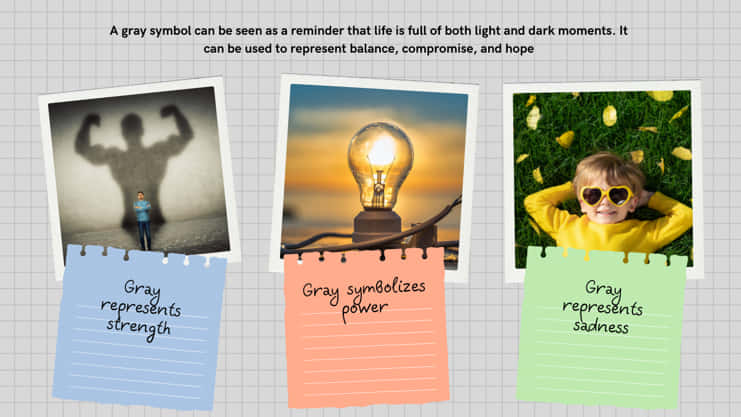Gray is a color that is often seen as dull or boring. However, grey has a lot of symbolism and meaning behind it. In this guide to the color grey, we will explore what the color grey means historically and today.
We will also discuss the different shades of grey and how to use them in your designs. So whether you’re looking for grey wedding ideas or want to know more about this underrated color, keep reading!
The color grey has been associated with sadness and depression for many years. The term “grey matter” is often used to describe the brain area that controls emotions. However, grey can also be seen as a color of hope and resilience.
This is because grey is the color of clouds and rain, essential for new life to grow. Grey is also a color of balance, as it is the middle ground between black and white.
This post is part of a series on color meanings, where you may learn more about white color meaning, yellow color meaning and other colors.
The Color Gray Meaning
The gray color meaning can be quite complex, as it is often seen as a dull, dirty, and dingy color. However, it can also be seen as a formal, conservative, and sophisticated color. Gray is also often associated with loss or depression.

The gray color can cause unsettling feelings in the mind and body, so it is often seen as a negative color. However, gray also has some positive connotations, such as being a sophisticated color.
If you are looking to add gray to your life, it is essential to understand the different gray color meanings before doing so.

Dark gray meaning:
The dark gray color is associated with sadness, gloom, and depression. It can also convey feelings of anger, frustration, and even fear. In some cases, dark gray can also represent death or mourning.
Gray day meaning:
A day gray is often seen as dull, gloomy, and depressing.
Light grey color meaning:
The light gray color is associated with feelings of boredom, neutrality, and detachment. It can also represent sadness and depression. In some cases, light gray can also symbolize new beginnings or freshness.
Silver Grey meaning: This is the color associated with spirits. It has also been linked to good things. It emphasizes our mental and physical connection. Those who have this sort of aura are generally individuals who meditate and practice yoga.
Charcoal Grey color meaning:
The Charcoal Gray color is associated with mystery, the unknown, and the hidden. It can also be used to represent strength, power, and determination. In some cases, Charcoal Gray can also be used for mental illness.
Some popular meanings of the color gray
- The term “gray area” is used to describe something that is unclear or undefined.
- The word “gray-out” can describe a power outage or loss of signal.
- “Gray matter” refers to mental faculties, intellect, brains, and intellect.
- The term “gray power” is used to describe the strength of the elderly or senior citizens.
- “gray page” refers to a text-heavy page with very little contrast or white space.
- An elderly person with gray or white hair is sometimes referred to as “gray hair.”
- “Gray water” is water that has been drained from a bathtub or kitchen sink.
- The color gray is often associated with feelings of sadness and depression.
- Gray can also be seen as a color of neutrality or lack of emotion.
- In fashion, gray is often seen as a sophisticated, timeless color.
- Gray is the perfect color for other brighter colors to use as a backdrop.
Different type of Gray shade and their meaning

- Achromatic Gray: Achromatic gray is the perfect balance of colors. It signifies order and calmness. When you see this color in an environment, it can positively affect your mood and performance. We often see this color used in offices and other professional spaces.
- Off-Gray: Off-gray is a warm, inviting colour. It’s often used in home décor because it makes rooms feel cosy and inviting. This color can also be used to create an elegant look.
- Cool Gray: Cool gray is a modern, sophisticated color. It’s often used in minimalistic design to create a clean, sleek look. This color can also make a space feel more spacious and open.
- Warm Gray: Warm gray is a soothing, calming color. It’s often used in nurseries and children’s spaces because it has a soothing effect. This color can also be used to create a cosy, inviting space.
- Gray-Blue: Gray-blue is an excellent, refreshing color. It’s often used in bathrooms and kitchens because it creates a clean, fresh look. This color can also make a space feel more spacious and open.
- Green-Gray: Green-gray is a refreshing, nature-inspired color. It’s often used in gardens and other outdoor spaces because it evokes a sense of tranquillity. This color can also be used to create an inviting, welcoming space.
- Purple-Gray: Purple-gray is an excellent regal color. It’s often used in bedrooms and other relaxing spaces because it has a calming effect. This color can also be used to create an elegant, sophisticated space.
History of the Color Gray
The color gray is often associated with sadness, but did you know its history is quite interesting? While the exact origin of the color gray is unknown, historical evidence shows that the word ‘gray’ was first used as the color’s name as early as AD 700.

It was the color commonly worn by the poor in the Middle Ages, associating it with poverty. Cistercian monks and friars also wore this color to symbolize their vows of poverty and humility.
Interestingly, the color gray began to be associated with sophistication in the 18th century. This was partly due to the popularity of novels such as The Gray Monk by Walter Scott, which depicted monks as intelligent and wise.
Today, the color gray is still often associated with intelligence, maturity, and formality.
What is the spiritual meaning of gray color?
Gray is the color of neutrality and can be seen as a balance between the black and white extremes. It can also be seen as a blending of both light and dark, illustrating the idea that everything has its own time and place.
Gray can symbolize transition, change, compromise, or ambiguity in spiritual terms. It can also indicate a lack of commitment or a feeling of being stuck in limbo.
In difficult life situations, grey can be a sophisticated color choice. It can help create a sense of calm and can be used to ground oneself when things feel overwhelming. It can also help gain perspective and understand that everything is temporary. When used in this way, grey can be a very powerful color.
This intense color improves your spiritual power and creates physical energy in your body.
Grey as a color for meditation and reflection
When using grey as a color for meditation and reflection, it can help to symbolize the neutrality and balance that is possible in this state. It can remind us that all things are temporary and that there is always something to learn. In times of chaos or confusion, grey can be a grounding force, helping to bring clarity and understanding.
You can love gray days because they offer a chance to reset and recharge. Embrace the gray and find the beauty in it. It is a color that can help you find your centre and connect with your higher self. Use grey to create balance in your life and bring peace to your soul.
Spiritual properties of the gray color
1. coastal and segregate
The gray color is often associated with neutrality, detachment, mental and physical energy. This can be seen in its coastal and segregated properties. It does not take sides in conflicts and instead remains impartial. This can be a dream, meaning for those struggling to make a decision or find themselves in the middle of a conflict.
2. Conservative and Quiet
Gray is also associated with being conservative and quiet. This is due to its ability to blend in and not stand out. It is often seen as a color of stability and reliability.
3. Dependable and predictable
Gray is often seen as a dependable and predictable color. This is because it is not prone to sudden changes or mood swings. It is seen as a reliable source of comfort and support.
4. Elegant and sophisticated
Gray is also associated with being elegant and sophisticated. This is due to its ability to convey a sense of refinement and sophistication. It is often used in formal settings and can be seen as a symbol of status.
5. Mature and wise
Gray is often seen as a mature and wise color. This is due to its association with experience and knowledge. It is often seen as a color of wisdom and authority.
In conclusion, the gray color has many spiritual properties that can be beneficial for those struggling in their lives. It is a reliable source of support and can help to provide stability in times of upheaval.
It is also a wise and experienced color that can offer guidance and advice. If you are feeling lost or confused, consider using the gray color in your life to help you find your way.
What do you think about the spiritual properties of the gray color? Do you see them as beneficial? Let us know in the comments below!
Color Gray Meaning in Your Dreams
When dreamers see the color grey in their dreams, it can symbolize several things depending on the dream’s context. In general, grey can represent neutrality, balance, and transition. It can also indicate a lack of commitment or feeling stuck in limbo.
Dreamers may use grey to represent their negative emotions in difficult life situations, such as sadness, anger, or fear. Alternatively, grey can also be a sign of depression.
If you dream that everything around you is grey, it may indicate that you’re feeling hopeless or trapped in your current circumstances.
On the other hand, dreamers may also see grey as a positive symbol. In these cases, it can represent wisdom, practicality, and calm. It can also be a sign of your ability to objectively see both sides of a situation. If you dream that the color grey surrounds you, it may signify that you’re in a period of transition or growth.
Positive And Negative Aspects of the color gray
Positive Aspects
Negative Aspects
Gray symbolism
A gray symbol can be seen as a reminder that life is full of both light and dark moments. It can be used to represent balance, compromise, and hope.

Gray can also be seen as a color of transition, representing the space between two worlds. In literature, gray symbolism is often used to create a mood of melancholy or sadness.
Gray represents strength: The color gray symbolizes strength and durability since it is the color of gravel, granite, and stone. It’s unemotional, dispassionate, balanced, and impartial.
Gray symbolizes power: The color gray is often associated with power, authority, and control. It can be seen as a color of stability and structure. Gray is also a color of knowledge and wisdom.
Gray represents calmness: The color gray is often associated with feelings of calmness and serenity. It’s a stable, reliable, and secure color. Gray can also be seen as a color of modesty and humility.
Gray represents sadness: The color gray is often associated with sadness, grief, and loss. It can be used to create a mood of melancholy or despair. Gray is also a color of loneliness and isolation.
Gray symbolism in different culture
- Gray was a color found in the heron’s plumage in Ancient Egypt, which had connotations with Egyptian gods. Because the heron was considered to be the guide to the underworld, so too was its hue.
- In the Middle Ages, gray was seen as the color of mourning. It was also associated with death and dying. Gray symbolism in literature often reflects these dark connotations.
- In China, the color gray is associated with water and symbolizes cleansing and purification.
- In Japan, gray is a popular color for Zen gardens because it represents simplicity and balance.
- Gray is seen as the most steadfast of all hues in Africa. It represents a firm beginning and also signifies maturity, solidity, security, and power.
Final word
Although gray is often seen as a color of sadness and negativity, it can also be viewed as a symbol of neutrality, balance, and calm. It can create feelings of security and reliability in designs, making it an excellent choice for use in corporate branding or products aimed at the mature market.
When used correctly, gray can provide a sense of order and stability in an otherwise chaotic world. Have you ever used the color gray in your designs? What was your experience? Let us know in the comments below.